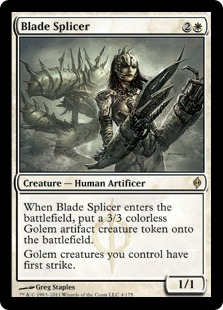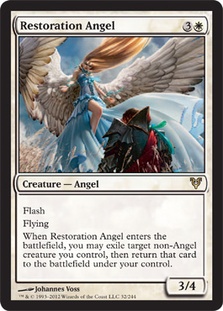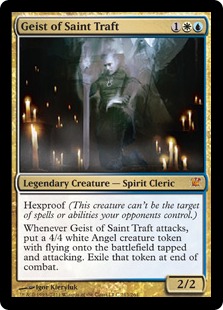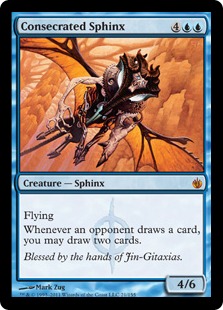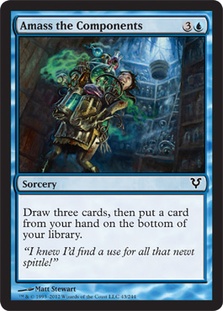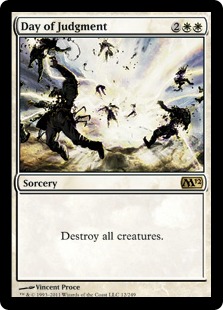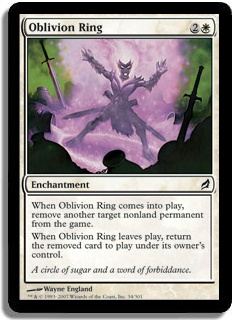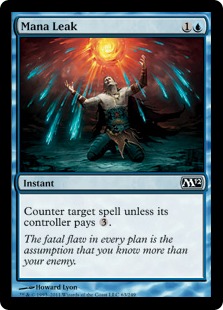I’m sure it doesn’t come as much of a surprise that I sleeved up four (eight, if you count Legacy) Delver of Secrets this past weekend. What’s more interesting is how close I was to leaving them at home.
My story of SCG Open Series: Worcester starts last Tuesday, when Sam Black posted this decklist:
Creatures (14)
Planeswalkers (4)
Lands (10)
Spells (32)

It didn’t take very long for this "Delverless" deck to catch on. It was something new and different, while still playing Restoration Angel and the same powerful blue instants and sorceries as traditional Delver. By Wednesday night the deck was all over Magic Online, performing well in Daily Events and representing a surprisingly large portion of the metagame for a recent innovation.
I had to find out for myself, so I spent a good part of Thursday morning playing the deck in two-man queues. After this session and my experiences with normal Delver, I arrived at the following conclusions:
1. The Blade Splicer– Restoration Angel interaction really is that good.
Playing against beatdown decks with Delver is sometimes a scary proposition. You have a number of cards that are awkward against them, such as Geist of Saint Traft and equipment. Delver doesn’t have real removal spells—just ways to buy time. Blade Splicer solves this problem because it helps to stabilize the board while also serving as a threat you can race with or use as a win condition once you’ve stabilized. Any time I was able to use Restoration Angel with Splicer against a creature deck, I felt like the game was over.
Now that Restoration Angel has been a known quantity for nearly a month now, it’s more important to get value out of the enters the battlefield trigger than ever before. Most decks are equipped to deal with the Angel itself via Dismember, Plummet, Doom Blade, or any number of other removal spells that have begun to see more play as a result of the 3/4. Blade Splicer really pushes Angel’s effectiveness over the top, making it more like Mistbind Clique and less like Nephalia Seakite.
2. Geist of Saint Traft has gotten worse.
Geist is an extremely powerful threat, but it also lives and dies based on the types of cards that see play. Geist isn’t a great card against modern aggressive decks because those decks have been designed with Vapor Snag in mind. They have low curves, are very aggressive, and plan to create an overwhelming board presence. It’s very hard for Geist to attack and survive against these decks, and it does nothing to help you defensively.
In addition, Phantasmal Image is seeing a tremendous amount of play, with most blue decks having access to between three and four Clone effects, sometimes in addition to Geists of their own. In the Delver mirror, they even have Restoration Angel as an effective way to fight Geist in combat. I’ve also noticed a decline in the number of equipment that Delver players can afford or want to play—which certainly diminishes the effectiveness of Geist. Even in the Delver mirror games are slated to go long after sideboarding, so players try to board out a Vapor Snag or two. This makes it even harder to stay aggressive with Geist.
Control is traditionally the matchup where Geist is at its best, but the only control deck that sees play right now is Esper. Esper has Lingering Souls to clog the board along with maindeck Phantasmal Image, Liliana, and Day of Judgment as relatively effective answers to Geist.
Simply put, things are very hostile for Geist at the moment. At the very least, it is harder to make Geist effective than ever before, and answers to it are very prevalent and efficient.
3. Sam’s deck has trouble with Delver in game 1.
On the surface, this matchup looks very much like a mirror. The decks share the same card selection engine, the same answers, and relatively similar threats. In many ways, they are the same deck except that one has four Delver of Secrets and one has four five-drop planeswalkers. Notice a problem?
The matchup hinges on the fact that U/W Midrange is typically on the back foot, which increases the effectiveness of Delver’s Snags and Leaks while making Midrange’s awkward and easy to play around. Sam’s idea was to win the longer and more grindy games, but it’s difficult to sculpt those types of situations when you’re always on the defensive and infrequently able to apply pressure.
Despite just talking about how much worse Geist of Saint Traft has gotten, it is the easiest card to lose to with U/W Midrange.
4. U/W Midrange is exactly the deck that I want to be after sideboard against most decks.
Since Grand Prix Minneapolis, Delver decks have been able to sideboard into a stunted U/W control deck, typically with Consecrated Sphinx and sometimes with Day of Judgment or Amass the Components. This sideboard plan is very effective and results in a deck that looks very similar to Sam’s midrange deck. The primary problem with it was that you were always stuck with either Delver of Secrets or Geist of Saint Traft (typically Delver) in the postboard control configuration. Neither of these cards is particularly exciting for a control deck, especially one with Day of Judgment.
As the metagame developed in a way where most decks were aware of Delver’s sideboard, I realized I wanted more than just a couple control elements in mine. I didn’t really want to play Sam’s deck in a tournament—I wanted to sideboard into it.
Here’s the deck I registered on Saturday in Worcester:
Creatures (18)
Lands (22)
Spells (20)

On my Magic Online account, I have this deck saved as "U/W Hybrid." The deck functions as the middle ground between U/W Delver and Midrange, utilizing its sideboard to fill the gap between the two.
The main problem I tried to solve was a way to equalize the Delver matchup in game 1 without sacrificing too many edges in other matchups. I quickly realized that Blade Splicer already put me in a better position than Geist-Delver against most beatdown decks and that Sam’s planeswalkers were probably not necessary in game 1.
Adding Delver of Secrets back in the deck served three primary purposes. Against Geist-Delver, I was able to have the same mana curve only with slightly different threats. I didn’t want to be forced into a defensive role and lose to more effective Snags and Leaks. By playing Delvers of my own I was able to put pressure on the opponent, which sometimes could allow me to be the aggressor with better Leaks and Snags. At the very least it could bring parity to the matchup, which eventually could be broken down by my superior late game.
In addition, forcing an opponent in any matchup to interact with Delver makes Blade Splicer even better. A problem I encountered with the midrange deck was that the first removal spell would always be aimed at Splicer, mitigating the advantage of having "better Angels."
Lastly, I didn’t really want to sacrifice the free wins that Delver gives you. Sometimes you flip an early Delver or two with Mana Leak backup and win regardless of what the opponent is playing.
One thing you’ll notice about the sideboard is a relatively small number of instants and sorceries. Another trend I noticed with my Delver lists was that many of the cards I wanted to side in were not able to flip Delver, so my Delvers were not only less cohesive with my game plan after sideboarding but also generally less effective.
Oblivion Ring was a concession to tight sideboard space, since I wanted some number of Celestial Purges, artifact removal, and answers to planeswalkers. O-Ring allowed me to have access to all those things in less total cards and also overperformed during the tournament itself. It was so good that the one Celestial Purge in my sideboard probably wasn’t necessary, as I felt Zombies was an easy matchup despite never drawing the Purge.
As for the tournament itself, I played against aggressive decks five times: G/R twice, Naya once, and Zombies twice. All of the matches were convincingly in my favor, with Day of Judgment and Gideon Jura doing more than their fair share of the work. An important interaction that came up multiple times was Gideon Jura plus Restoration Angel. Against one Zombies player, he was consistently able to attack my Gideon down to one or two loyalty, at which point I would activate Gideon, attack, play Angel, and reset Gideon. This allowed me to present a clock, reset my Gideon, and protect it all in the same turn. This play is devastating against any aggro deck as long as you can keep track of their Doom Blades and Combusts (which conveniently kills Gideon through his damage shield).
Counting the Top 8, I played against Geist-Delver five times, losing only the once to my semifinals opponent Shawn Herr. Shawn is a Northeast player who I’ve known for a number of years on the PTQ scene. He also defeated Ben Friedman, the only other person playing my deck. I was really impressed with Shawn’s play in our match and throughout the tournament, and it doesn’t surprise me that he went undefeated until the finals.
The Delver matchup played out as I expected, as I was able to play a normal aggressive game preboard but also had more options after sideboard. I felt all day like I was painting my opponents into a corner of having to choose between staying aggressive and sacrificing the long game or preparing for a grindy match and losing to my higher land count/more controlling deck.
Sideboarding with this deck is a fluid art, even more than normal. I typically don’t like to give strict sideboard guides, and I think it would be impossible to do so for this deck. I sided out Delvers every round during the tournament, though I think that was partially due to the element of surprise I gained from having an unknown decklist.
Along with Delvers, I think you want to cut Mana Leaks and some number of Probes against aggressive decks. In addition, I was typically cutting at least one Snag, and against Zombies both Dismembers. I typically like have some number of Images against aggressive decks, but I wouldn’t necessarily play all four unless they are maxed out on Thalia and Blade Splicers of their own like Naya is. Oblivion Ring is a card that helps make your Day of Judgments better, since you can usually hit their one undying threat against R/G and Zombies or take care of a Sword that would make their position better post-Day. It’s nice to have a hard removal spell to deal with whatever follow up they may have to hold you over until you can land a game-ending threat.
The Delver matchup is the most dynamic in terms of sideboarding, as it’s very dependent on their list and also how they play the matchup. To some extent, there’s a guessing game as to whether they are going to bring in big guys and whether or not they’ll keep their Leaks in. Typically, I find it’s nice to have lots of options since the games go so long that you’ll get the opportunity to see a ton of cards. I even had the opportunity to cut an extra Leak (down to one) for a Dissipate against one opponent who was very patient and willing to play for the long game. Snag is typically not great against Delver, though you do need a few to survive an aggressive game.
I would generally cut my Delvers, 1-2 Snag, and 2 Leaks in the matchup. Timely Reinforcements is typically only good on the draw, and Oblivion Ring only came in if I thought they would keep Sword of War and Peace in (I don’t care about Feast and Famine). Looking back, I do really wish I had an Amass the Components (a card I was initially very skeptical of) to put me ahead in certain situations.
The thing I like the most about this deck is the ability to make it your own. If you have an intuitive understanding of sideboarding and a way you plan on playing each matchup, then you have a big advantage over someone who is sticking to a predetermined or generic strategy. One thing I’ve noticed that separates a good Delver player from everyone else is a very strong, developed opinion on what is right. These ideas often conflict drastically with those of other successful players, but it doesn’t matter since the deck is so dynamic and customizable.
This deck may seem very much like something you have seen before on the surface, but changing a few cards is huge when you’re trying to get small edges. Even though it looks similar, the games play out very differently than what you might be used to.
I’d recommend trying this deck and cutting the cards you don’t like. There’s nothing worse than sideboarding in a card to your deck when you don’t like it or even understand what it’s for. Hopefully my advice is helpful, but more importantly, I hope a look into my thought process has helped you understand how to evolve a deck and how to let (or not let) your own skills and biases affect the deckbuilding process.
It’s easy to look back every week and see that Gerry Thompson was One Step Ahead. How many steps ahead should you be?

